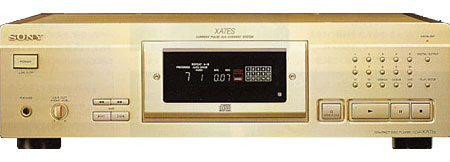| Columns Retired Columns & Blogs |
Any chance of digging into the archives and putting the Sony 779 ES cd player by J. Gordon Holt (Aug. 1993) review online?

The real world is never that simple. Big companies have the expertise, production facilities, and economies of scale to produce exceptional products if they put their minds to it. And sometimes they do put their minds to it. Sony has been making solid, well-engineered, genuinely high-end CD players for many years. The CDP-XA7ES is the latest flagship model in the premium ES series.
Wrestling its 33-lb weight out of the shipping carton was a clear sign that the CDP-XA7ES is hardly your typical disposable consumer CD player (though your first clue will come when you sign that check or loan agreement for three big ones!). This baby is as solid as they come, and the weight is not deceptive. The Sony's solidity begins with a rigid frame-and-beam internal construction (sounds like something out of an auto advertisement). The chassis is copper-shielded—a popular design feature on high-end Japanese electronics. Sony says that this reduces magnetic interference. They must mean AC electromagnetic interference—copper is of no use against nonchanging magnetic fields, otherwise they'd use it to shield home-theater loudspeakers. The aluminum front panel, top plate, and ceramic disc tray are said to be anti-resonant. The motor has sapphire bearings, and the laser tracking utilizes digital servo control.
The laser pickup of the CDP-XA7ES is unusual. Typically, a CD is spun in place while a moving laser assembly tracks the recording. In the Sony, the laser pickup is fixed; the spindle and disc move on a motor-driven sled. You can see this mechanism in operation the first time you open the disc-loading tray: The latter moves outward at a different rate than the spindle itself.
Inside the Sony, a twin toroidal power transformer feeds separate power supplies for the analog and digital circuitry. Sony's Direct Digital Sync;r circuitry is said to reduce jitter. The digital filter is a feed-forward design with 8x-oversampling, and the digital/analog converter is Sony's "current pulse" design—Sony's take on one-bit conversion technology. Twenty-bit output resolution claimed, though of course, with a CD's 16-bit word length, this is not possible in reality.
There are three sets of analog outputs (balanced, unbalanced fixed output, unbalanced variable output) and two digital outputs (coaxial and TosLink optical), plus a headphone output with level control. A rear-panel switch turns the balanced outputs on or off; a front-panel switch does the same for the digital outputs. The same motor-driven pot that controls the headphone output also controls the variable-level line outputs. Also, the CDP-XA7ES's balanced outputs are transformer-coupled.
The full-function remote control, together with the front-panel controls, provides all the usual bells and whistles. There are choices for the front-panel display mode (elapsed or remaining time on the current track or the remaining time on the disc). There's a scanning mode (Music Scan) to preview the first 10 seconds of each track, and a random mode (Shuffle Play) to keep you guessing as to which track is coming next. You can, of course, program to your heart's content, and there are "Custom Files" to allow you to pre-program up to 224 discs (everything digital seems to come in multiples of 16) and play each one back as programmed whenever you load it in the player. (The programming is, of course, stored in the player, not on the disc.) You can search for the peak level on a disc (useful for tape dubbing), and an auto space function may be selected to insert a three-second blank between each track. There's also a fade-in/fade-out mode with variable fade times. Unfortunately, this works only from the analog outputs, making it of little value for DAT (or CD-R) compilations—unless you want to go through the potential degradation of an extra D/A and A/D conversion cycle.
Even if you never use all the programming and gee-whiz features (most audiophiles I know never do—I wonder if "civilians" watching "12:00" flashing on their VCRs will figure them out), the Sony CDP-XA7ES has a slick, silky feel throughout that anyone will appreciate. The controls feel expensive (Hondalike, to use another automotive analogy). And, as with all top-of-the-line Sony CD mechanisms I've seen, the loading drawer opens and closes with a silky, quiet precision rare in any CD player or transport, regardless of price. A manual disc clamp is furnished with the player, and is required for playback. My only ergonomic complaint—a minor one—rests with this clamp. It's smoothly finished, and its finger-grip surface is very slippery. I never dropped it, but I'm certain that plenty of others will. While not particularly heavy, it's massive enough to damage a favorite disc if you let it fly accidentally.
Sound
We review a lot of CD players and transports/processors here at Stereophile, some of them very expensive. In that context, the Sony CDP-XA7ES is almost mid-priced. But $3000 is still a lot of money for a CD player; as I began my auditioning, I thought, "This thing had better deliver.

Any chance of digging into the archives and putting the Sony 779 ES cd player by J. Gordon Holt (Aug. 1993) review online?

Any chance of digging into the archives and putting the Sony 779 ES cd player by J. Gordon Holt (Aug. 1993) review online?
It's in the queue.
John Atkinson
Editor, Stereophile

... was there a follow-up report?
https://www.stereophile.com/content/sony-cdp-x779es-cd-player